Abstract
1. Endothelium-dependent hyperpolarization of smooth muscle cells in isolated, pre-contracted segments of rabbit basilar artery in response to acetylcholine (100 microM) was abolished in the presence of glibenclamide (10 microM). 2. Acetylcholine-evoked relaxation was unaffected by either glibenclamide or 65 mM potassium chloride, indicating that the change in membrane potential did not form an essential component of relaxation and that high concentrations of potassium did not inhibit the release or action of endothelium-derived relaxing factor in this vessel. 3. Saturated solutions of nitric oxide (NO) gas in solution (150 microM), which evoked maximal relaxation of arterial segments pre-contracted and depolarized by noradrenaline (10-100 microM), did not alter the membrane potential of either unstimulated or depolarized smooth muscle cells. 4. The potassium channel opener levcromakalim, evoked concentration-dependent relaxation and hyperpolarization in pre-constricted smooth muscle cells. The threshold concentrations for hyperpolarization and relaxation, the EC50 values and the maximally effective concentration of levcromakalim (around 30 nM, 150 nM and 10 microM, respectively) were not significantly different, and both components of the response were inhibited by glibenclamide (10 microM), indicating a close coupling between the two responses. 5. In the presence of 65 mM potassium chloride, the hyperpolarization to levcromakalim was abolished, while a small relaxation (25 +/- 4%) persisted, indicating an additional mechanism for relaxation to this agent.(ABSTRACT TRUNCATED AT 250 WORDS)
Full text
PDF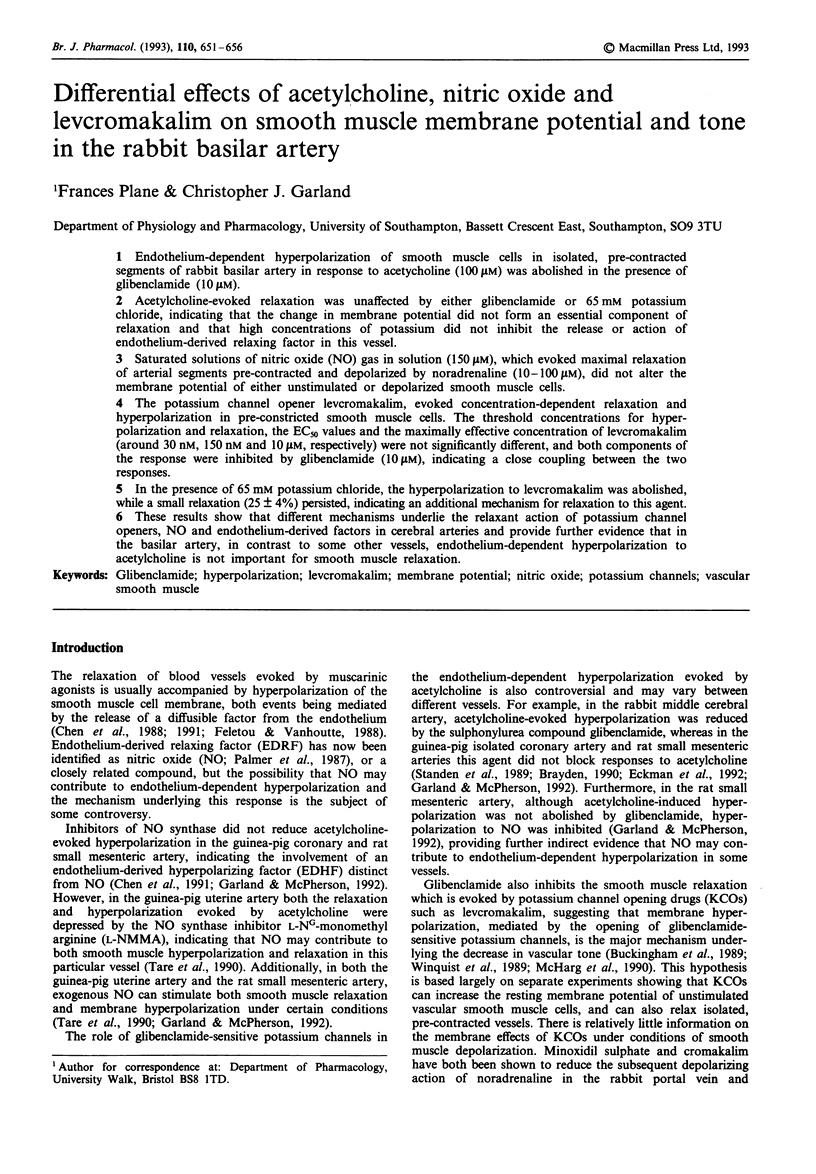
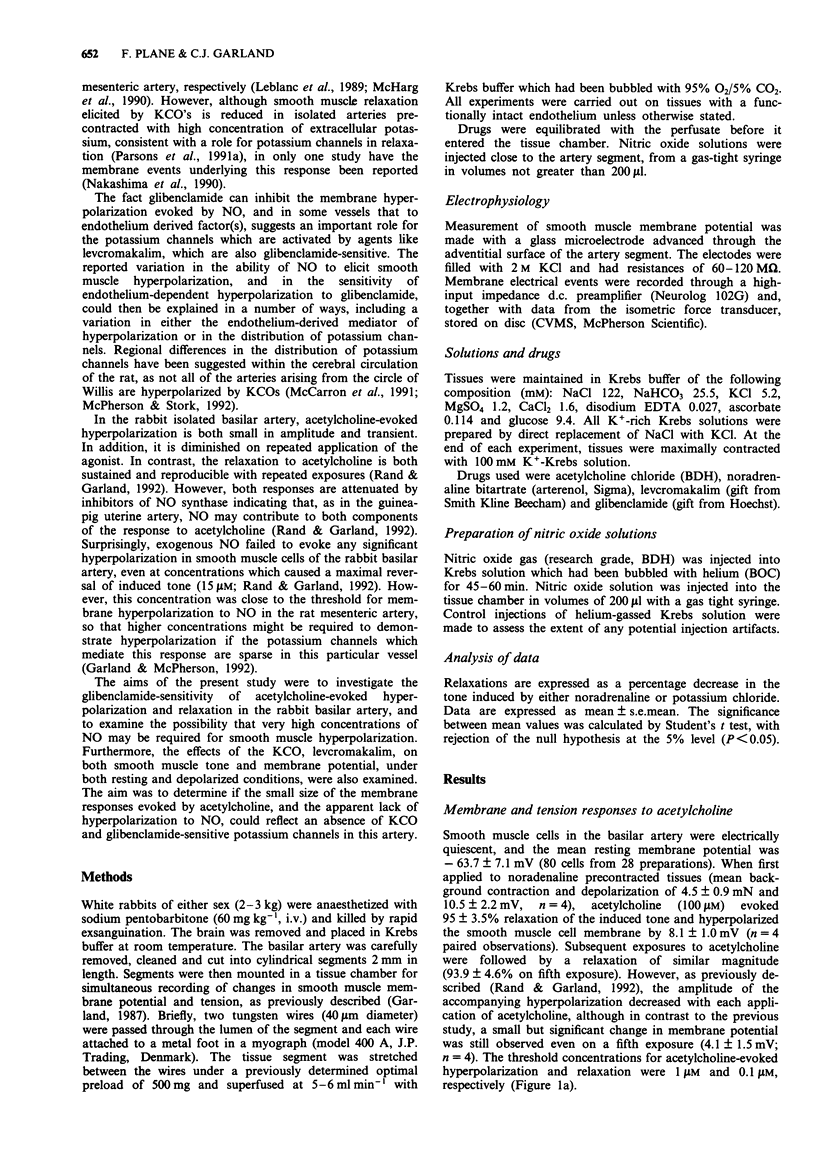
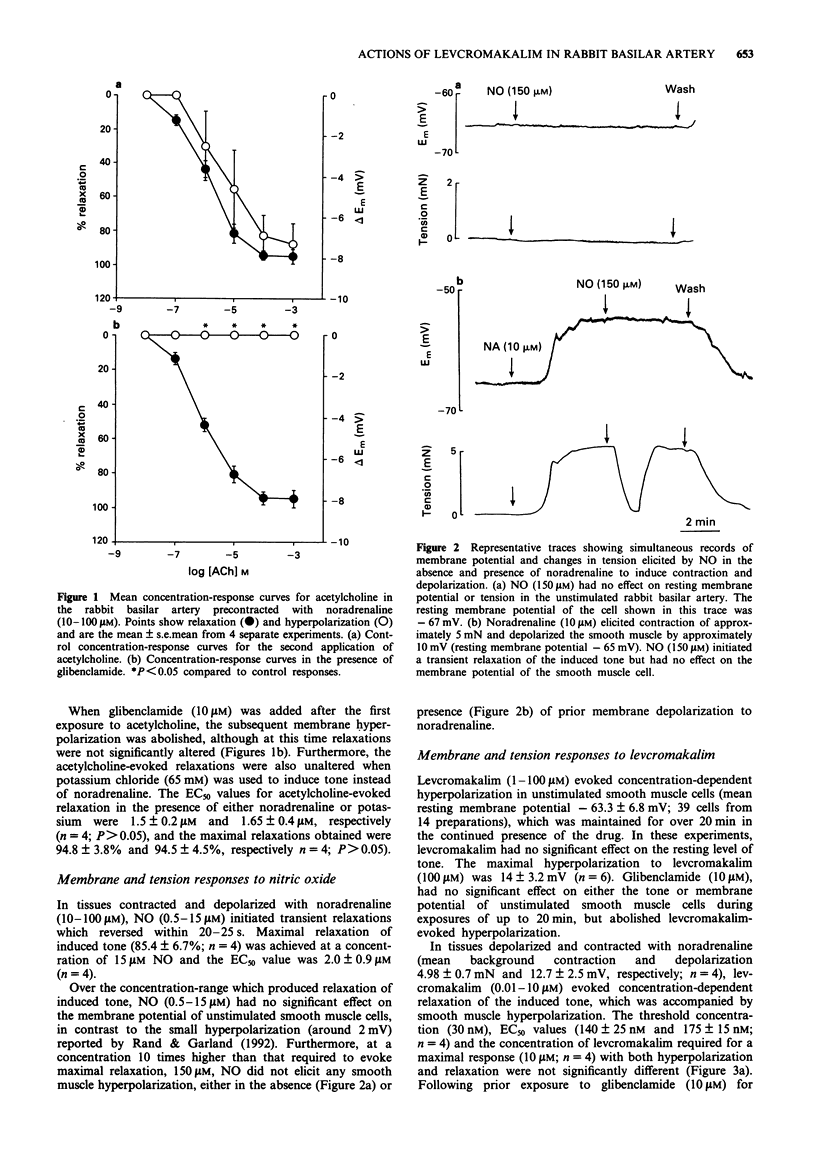
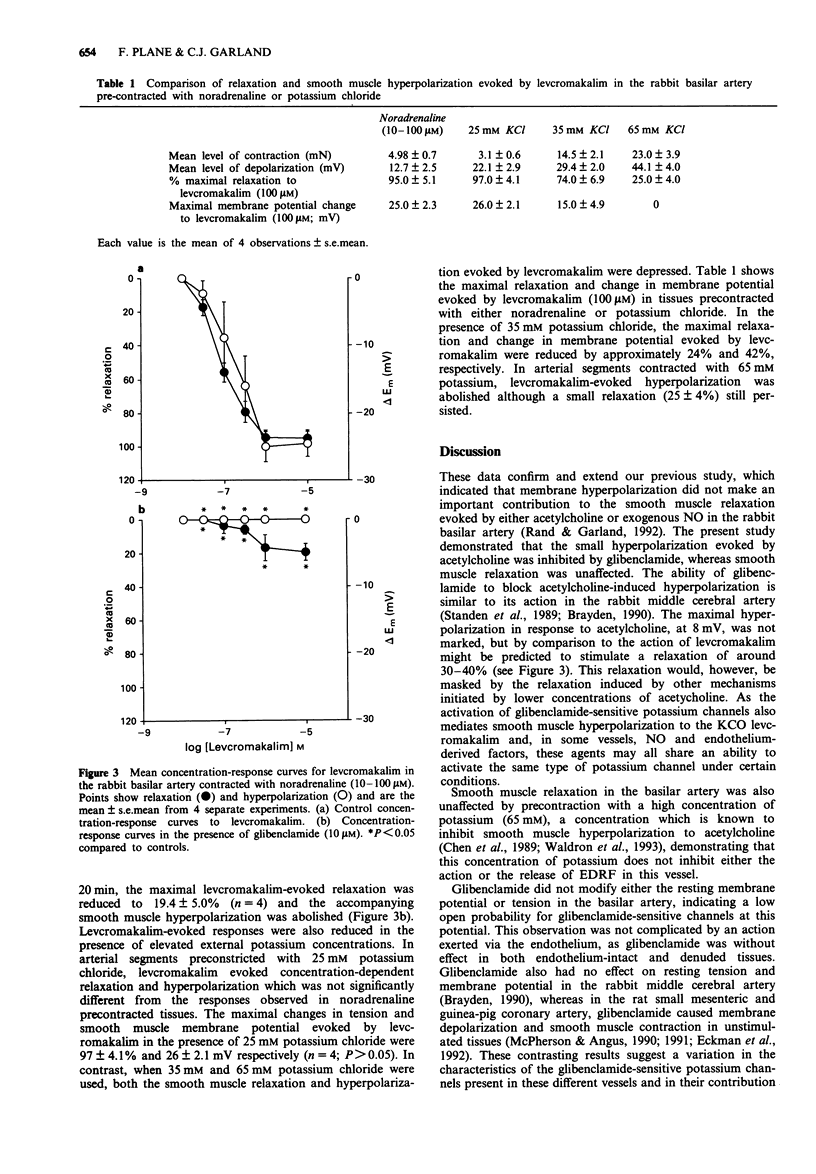
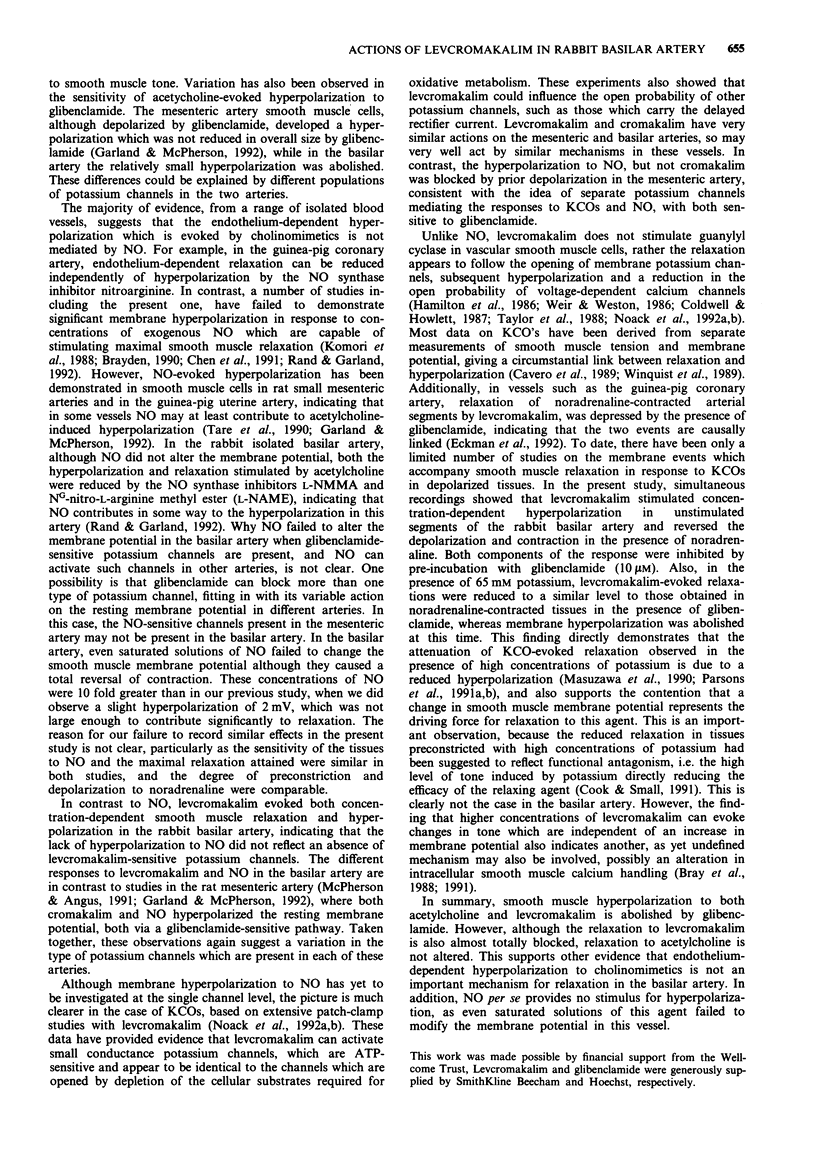
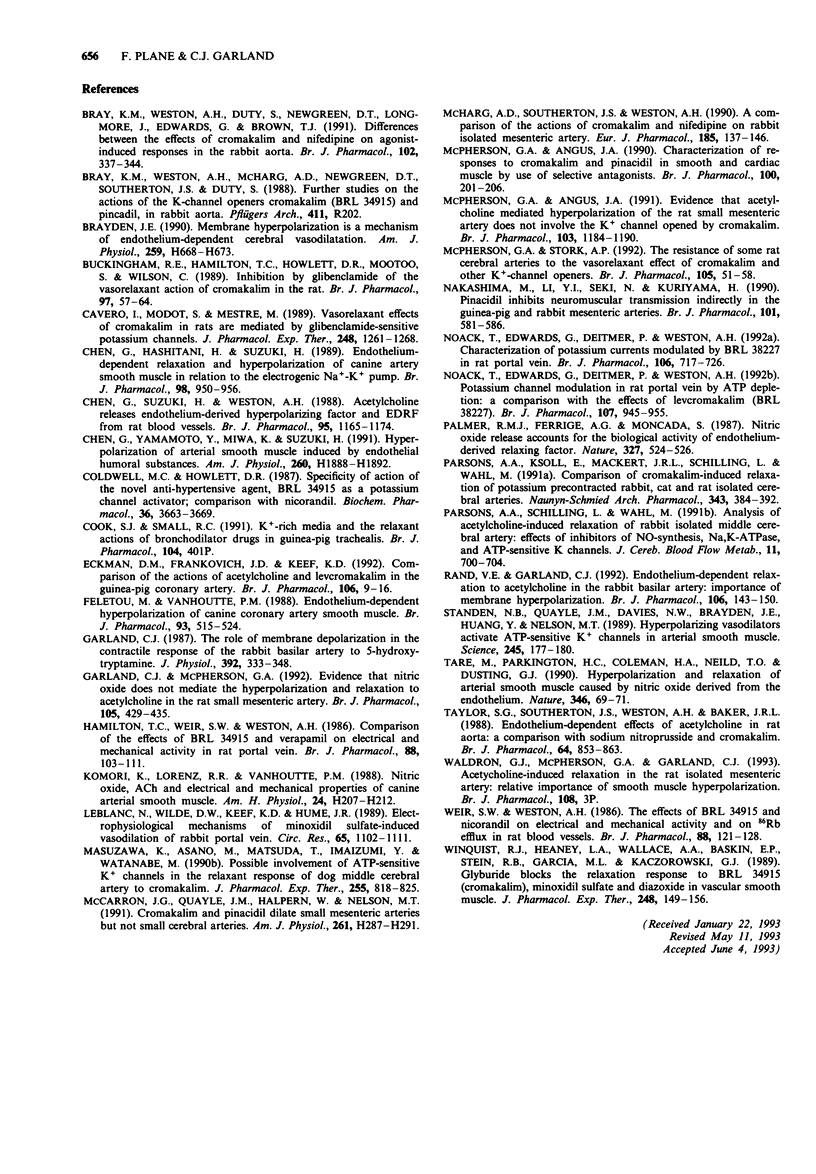
Selected References
These references are in PubMed. This may not be the complete list of references from this article.
- Bray K. M., Weston A. H., Duty S., Newgreen D. T., Longmore J., Edwards G., Brown T. J. Differences between the effects of cromakalim and nifedipine on agonist-induced responses in rabbit aorta. Br J Pharmacol. 1991 Feb;102(2):337–344. doi: 10.1111/j.1476-5381.1991.tb12175.x. [DOI] [PMC free article] [PubMed] [Google Scholar]
- Brayden J. E. Membrane hyperpolarization is a mechanism of endothelium-dependent cerebral vasodilation. Am J Physiol. 1990 Sep;259(3 Pt 2):H668–H673. doi: 10.1152/ajpheart.1990.259.3.H668. [DOI] [PubMed] [Google Scholar]
- Buckingham R. E., Hamilton T. C., Howlett D. R., Mootoo S., Wilson C. Inhibition by glibenclamide of the vasorelaxant action of cromakalim in the rat. Br J Pharmacol. 1989 May;97(1):57–64. doi: 10.1111/j.1476-5381.1989.tb11923.x. [DOI] [PMC free article] [PubMed] [Google Scholar]
- Cavero I., Mondot S., Mestre M. Vasorelaxant effects of cromakalim in rats are mediated by glibenclamide-sensitive potassium channels. J Pharmacol Exp Ther. 1989 Mar;248(3):1261–1268. [PubMed] [Google Scholar]
- Chen G., Hashitani H., Suzuki H. Endothelium-dependent relaxation and hyperpolarization of canine coronary artery smooth muscles in relation to the electrogenic Na-K pump. Br J Pharmacol. 1989 Nov;98(3):950–956. doi: 10.1111/j.1476-5381.1989.tb14625.x. [DOI] [PMC free article] [PubMed] [Google Scholar]
- Chen G., Suzuki H., Weston A. H. Acetylcholine releases endothelium-derived hyperpolarizing factor and EDRF from rat blood vessels. Br J Pharmacol. 1988 Dec;95(4):1165–1174. doi: 10.1111/j.1476-5381.1988.tb11752.x. [DOI] [PMC free article] [PubMed] [Google Scholar]
- Chen G., Yamamoto Y., Miwa K., Suzuki H. Hyperpolarization of arterial smooth muscle induced by endothelial humoral substances. Am J Physiol. 1991 Jun;260(6 Pt 2):H1888–H1892. doi: 10.1152/ajpheart.1991.260.6.H1888. [DOI] [PubMed] [Google Scholar]
- Coldwell M. C., Howlett D. R. Specificity of action of the novel antihypertensive agent, BRL 34915, as a potassium channel activator. Comparison with nicorandil. Biochem Pharmacol. 1987 Nov 1;36(21):3663–3669. doi: 10.1016/0006-2952(87)90017-7. [DOI] [PubMed] [Google Scholar]
- Eckman D. M., Frankovich J. D., Keef K. D. Comparison of the actions of acetylcholine and BRL 38227 in the guinea-pig coronary artery. Br J Pharmacol. 1992 May;106(1):9–16. doi: 10.1111/j.1476-5381.1992.tb14285.x. [DOI] [PMC free article] [PubMed] [Google Scholar]
- Feletou M., Vanhoutte P. M. Endothelium-dependent hyperpolarization of canine coronary smooth muscle. Br J Pharmacol. 1988 Mar;93(3):515–524. doi: 10.1111/j.1476-5381.1988.tb10306.x. [DOI] [PMC free article] [PubMed] [Google Scholar]
- Garland C. J., McPherson G. A. Evidence that nitric oxide does not mediate the hyperpolarization and relaxation to acetylcholine in the rat small mesenteric artery. Br J Pharmacol. 1992 Feb;105(2):429–435. doi: 10.1111/j.1476-5381.1992.tb14270.x. [DOI] [PMC free article] [PubMed] [Google Scholar]
- Garland C. J. The role of membrane depolarization in the contractile response of the rabbit basilar artery to 5-hydroxytryptamine. J Physiol. 1987 Nov;392:333–348. doi: 10.1113/jphysiol.1987.sp016783. [DOI] [PMC free article] [PubMed] [Google Scholar]
- Hamilton T. C., Weir S. W., Weston A. H. Comparison of the effects of BRL 34915 and verapamil on electrical and mechanical activity in rat portal vein. Br J Pharmacol. 1986 May;88(1):103–111. doi: 10.1111/j.1476-5381.1986.tb09476.x. [DOI] [PMC free article] [PubMed] [Google Scholar]
- Komori K., Lorenz R. R., Vanhoutte P. M. Nitric oxide, ACh, and electrical and mechanical properties of canine arterial smooth muscle. Am J Physiol. 1988 Jul;255(1 Pt 2):H207–H212. doi: 10.1152/ajpheart.1988.255.1.H207. [DOI] [PubMed] [Google Scholar]
- Leblanc N., Wilde D. W., Keef K. D., Hume J. R. Electrophysiological mechanisms of minoxidil sulfate-induced vasodilation of rabbit portal vein. Circ Res. 1989 Oct;65(4):1102–1111. doi: 10.1161/01.res.65.4.1102. [DOI] [PubMed] [Google Scholar]
- Masuzawa K., Asano M., Matsuda T., Imaizumi Y., Watanabe M. Possible involvement of ATP-sensitive K+ channels in the relaxant response of dog middle cerebral artery to cromakalim. J Pharmacol Exp Ther. 1990 Nov;255(2):818–825. [PubMed] [Google Scholar]
- McCarron J. G., Quayle J. M., Halpern W., Nelson M. T. Cromakalim and pinacidil dilate small mesenteric arteries but not small cerebral arteries. Am J Physiol. 1991 Aug;261(2 Pt 2):H287–H291. doi: 10.1152/ajpheart.1991.261.2.H287. [DOI] [PubMed] [Google Scholar]
- McHarg A. D., Southerton J. S., Weston A. H. A comparison of the actions of cromakalim and nifedipine on rabbit isolated mesenteric artery. Eur J Pharmacol. 1990 Aug 28;185(2-3):137–146. doi: 10.1016/0014-2999(90)90633-h. [DOI] [PubMed] [Google Scholar]
- McPherson G. A., Angus J. A. Characterization of responses to cromakalim and pinacidil in smooth and cardiac muscle by use of selective antagonists. Br J Pharmacol. 1990 Jun;100(2):201–206. doi: 10.1111/j.1476-5381.1990.tb15782.x. [DOI] [PMC free article] [PubMed] [Google Scholar]
- McPherson G. A., Angus J. A. Evidence that acetylcholine-mediated hyperpolarization of the rat small mesenteric artery does not involve the K+ channel opened by cromakalim. Br J Pharmacol. 1991 May;103(1):1184–1190. doi: 10.1111/j.1476-5381.1991.tb12321.x. [DOI] [PMC free article] [PubMed] [Google Scholar]
- McPherson G. A., Stork A. P. The resistance of some rat cerebral arteries to the vasorelaxant effect of cromakalim and other K+ channel openers. Br J Pharmacol. 1992 Jan;105(1):51–58. doi: 10.1111/j.1476-5381.1992.tb14209.x. [DOI] [PMC free article] [PubMed] [Google Scholar]
- Nakashima M., Li Y., Seki N., Kuriyama H. Pinacidil inhibits neuromuscular transmission indirectly in the guinea-pig and rabbit mesenteric arteries. Br J Pharmacol. 1990 Nov;101(3):581–586. doi: 10.1111/j.1476-5381.1990.tb14124.x. [DOI] [PMC free article] [PubMed] [Google Scholar]
- Noack T., Deitmer P., Edwards G., Weston A. H. Characterization of potassium currents modulated by BRL 38227 in rat portal vein. Br J Pharmacol. 1992 Jul;106(3):717–726. doi: 10.1111/j.1476-5381.1992.tb14400.x. [DOI] [PMC free article] [PubMed] [Google Scholar]
- Noack T., Edwards G., Deitmer P., Weston A. H. Potassium channel modulation in rat portal vein by ATP depletion: a comparison with the effects of levcromakalim (BRL 38227). Br J Pharmacol. 1992 Dec;107(4):945–955. doi: 10.1111/j.1476-5381.1992.tb13390.x. [DOI] [PMC free article] [PubMed] [Google Scholar]
- Palmer R. M., Ferrige A. G., Moncada S. Nitric oxide release accounts for the biological activity of endothelium-derived relaxing factor. Nature. 1987 Jun 11;327(6122):524–526. doi: 10.1038/327524a0. [DOI] [PubMed] [Google Scholar]
- Parsons A. A., Ksoll E., Mackert J. R., Schilling L., Wahl M. Comparison of cromakalim-induced relaxation of potassium precontracted rabbit, cat, and rat isolated cerebral arteries. Naunyn Schmiedebergs Arch Pharmacol. 1991 Apr;343(4):384–392. doi: 10.1007/BF00179043. [DOI] [PubMed] [Google Scholar]
- Parsons A. A., Schilling L., Wahl M. Analysis of acetylcholine-induced relaxation of rabbit isolated middle cerebral artery: effects of inhibitors of nitric oxide synthesis, Na,K-ATPase, and ATP-sensitive K channels. J Cereb Blood Flow Metab. 1991 Jul;11(4):700–704. doi: 10.1038/jcbfm.1991.123. [DOI] [PubMed] [Google Scholar]
- Rajanayagam M. A., Li C. G., Rand M. J. Differential effects of hydroxocobalamin on NO-mediated relaxations in rat aorta and anococcygeus muscle. Br J Pharmacol. 1993 Jan;108(1):3–5. doi: 10.1111/j.1476-5381.1993.tb13429.x. [DOI] [PMC free article] [PubMed] [Google Scholar]
- Rand V. E., Garland C. J. Endothelium-dependent relaxation to acetylcholine in the rabbit basilar artery: importance of membrane hyperpolarization. Br J Pharmacol. 1992 May;106(1):143–150. doi: 10.1111/j.1476-5381.1992.tb14307.x. [DOI] [PMC free article] [PubMed] [Google Scholar]
- Standen N. B., Quayle J. M., Davies N. W., Brayden J. E., Huang Y., Nelson M. T. Hyperpolarizing vasodilators activate ATP-sensitive K+ channels in arterial smooth muscle. Science. 1989 Jul 14;245(4914):177–180. doi: 10.1126/science.2501869. [DOI] [PubMed] [Google Scholar]
- Tare M., Parkington H. C., Coleman H. A., Neild T. O., Dusting G. J. Hyperpolarization and relaxation of arterial smooth muscle caused by nitric oxide derived from the endothelium. Nature. 1990 Jul 5;346(6279):69–71. doi: 10.1038/346069a0. [DOI] [PubMed] [Google Scholar]
- Taylor S. G., Southerton J. S., Weston A. H., Baker J. R. Endothelium-dependent effects of acetylcholine in rat aorta: a comparison with sodium nitroprusside and cromakalim. Br J Pharmacol. 1988 Jul;94(3):853–863. doi: 10.1111/j.1476-5381.1988.tb11597.x. [DOI] [PMC free article] [PubMed] [Google Scholar]
- Weir S. W., Weston A. H. The effects of BRL 34915 and nicorandil on electrical and mechanical activity and on 86Rb efflux in rat blood vessels. Br J Pharmacol. 1986 May;88(1):121–128. doi: 10.1111/j.1476-5381.1986.tb09478.x. [DOI] [PMC free article] [PubMed] [Google Scholar]
- Winquist R. J., Heaney L. A., Wallace A. A., Baskin E. P., Stein R. B., Garcia M. L., Kaczorowski G. J. Glyburide blocks the relaxation response to BRL 34915 (cromakalim), minoxidil sulfate and diazoxide in vascular smooth muscle. J Pharmacol Exp Ther. 1989 Jan;248(1):149–156. [PubMed] [Google Scholar]


